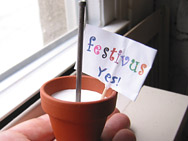 column_buckwolf
column_buckwolf
Introducing . . . Festivus Appreciation Day
'Seinfeld' Holiday Still Going Strong, Ready to Be Celebrated Any Time of the Year

At a Festivus party in Tampa Bay, Fla., Krista Soroka welcomes about 100 guests and gives each a 2-inch-tall Festivus Pole. (Warner Books)
By BUCK WOLF
Oct. 11, 2005 —
Seven yadda-yadda years after "Seinfeld"'s finale episode, Festivus – the holiday for people fed up with holiday stress – continues to be celebrated in homes, schools, offices, bars and parking lots. And now, the holiday for the rest of us is getting a lot more attention.Perhaps you've already welcomed a tinsel-free aluminum Festivus pole into your home, and you've celebrated just like George Costanza's fractured family, with the traditional Airing of Grievances – a time when family members let each other know what a disappointment they've been to each other.
These days, your cup can runneth over with Festivus Grape Ranch wine, and four varieties of Festivus beer. This Seinfeldian holiday has its own songs ("Gather 'Round the Pole"), recipes (Ham With Junior Mint and Snapple Glaze), and even a Miss Festivus pageant. If demand spikes, you can even be sure Ben & Jerry's will bring back Festivus flavor ice cream, which has already enjoyed two successful holiday runs.
TV has certainly done its share to shape holidays. Thanks to Seth Cohen's traumatic half-Jewish, half-gentile upbringing, "The O.C." can take credit for the explosion in Chrismakkuh cards, a genre of holiday greetings that include such images as a reindeer with menorah antlers. The "O.C." Web site even offers Chrismakkuh wrapping paper.
But one thing separates Festivus from all other holidays: It's not listed on any calendar – and its most fervent revelers demand it stay that way, so that Festivus can be celebrated without adding to pre-existing holiday pressure.
"One of the reasons Festivus is thriving is its flexibility," says Allen Salkin, author of "Festivus: The Holiday for the Rest of Us" (Warner Books), which hits bookstores later this month.
"Festivus is the alternative to holidays with fixed dates and fixed rituals and leaders telling you what you are supposed to do," Salkin says. "Like a wrestler, Festivus fights being pinned down."
You may think Festivus should be celebrated on Dec. 23 – the date the Costanza family celebrates. George's father, Frank, explains to Kramer in a landmark 1997 episode that he invented the holiday many years ago, after he found himself at a department store locked in a tug of war over a doll that got torn to shreds.
"I realized there had to be a better way," Frank said, so he invented Festivus, the holiday "for the rest of us."
The Costanzas' tradition begins with a bare aluminum pole, which Frank praises for its "very high strength-to-weight ratio." The pole is unadorned. Nobody gives any gifts.
After the Airing of Grievances is the Feats of Strength, a ritual that calls for family members to wrestle until the head of the household is pinned to the floor – another tension-releasing stress-beater.
But in his book, Salkin traces the first real-life Festivus back to 1966. It was invented by the father of "Seinfeld" writer Daniel O'Keefe, a sociologist and Reader's Digest editor in Chappaqua, N.Y., who wanted to start a fun, family tradition loosely based on ancient Roman festivals (or, as they say in Latin, "Festivi").
The first Festivus was held in February, to mark O'Keefe's parents' first date. Even then, there were bizarre rituals. "There was a clock in a bag," O'Keefe tells Salkin, although he does not recall what it came to symbolize, or when the aluminum pole took on significance.
These days, there are Festivus celebrations all year long, with various permutations. In some places, the Festivus pole is also used for limbo contests. Other places ring in the holidays with a little Festivus pole-dancing.











